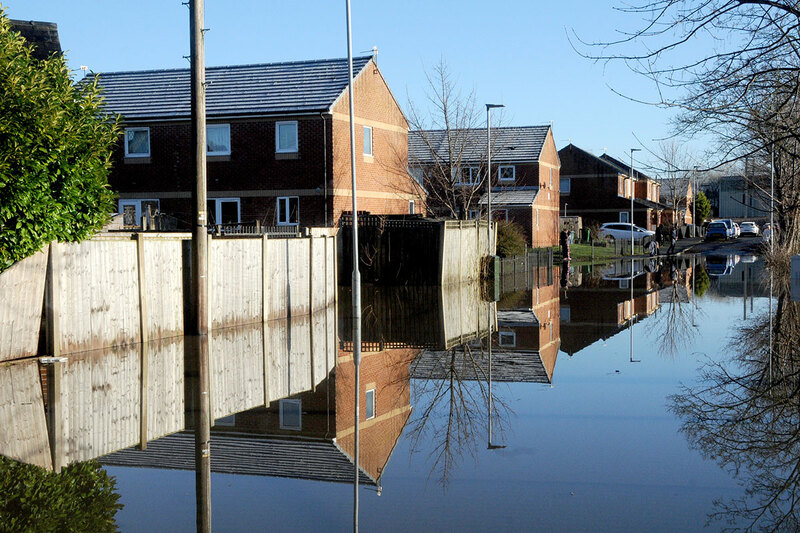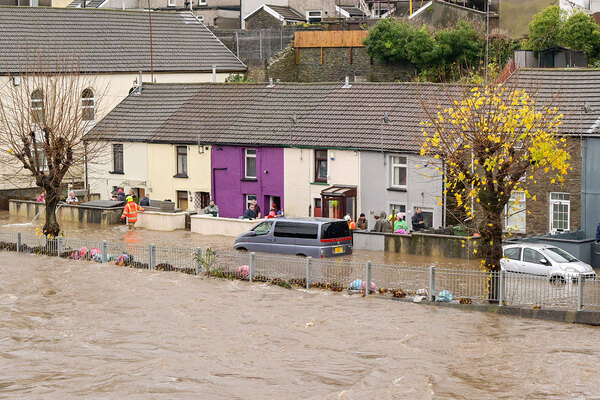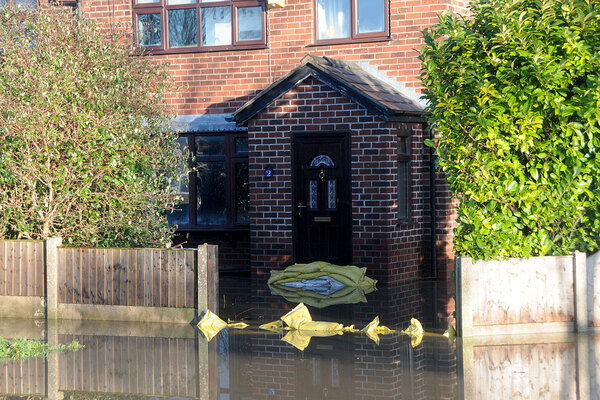You are viewing 1 of your 1 free articles
Flood risk is rising, and it is posing insurance problems for landlords – and residents
This January again saw residents being flooded out of their homes. The risk, and insurance costs, are rising. Gavriel Hollander reports
Paul Warburton went to bed in the early hours of New Year’s Day with plans to relax with his family and watch football the next day. Instead, the group director of housing services at North West landlord Torus found himself part of Warrington’s emergency response to a major flood. Earlier that morning, Sankey Brook had burst its banks, flooding several surrounding streets in the town’s Bewsey and Dallam quarters, forcing 60 families in Torus-owned properties to evacuate their homes.
“It was a long day,” he recalls. “I left the house at 11.30am and said to my wife I’d be home in a couple of hours. I got home at half eleven that evening.”
Mr Warburton wasn’t the only one who had to change his plans. Staff from across the business came in on their holiday as the Torus office became a triage centre for families who had been forced to evacuate their homes. Even chief executive Steve Coffey was enlisted to move residents from their flooded homes to the safety of the office in a bus.
While emergency planning, rescues and flood risk management are nothing new for landlords, they look set to become a more prominent part of their practice.
The Environment Agency is predicting a surge in the number of homes at flood risk, from 6.3 million to eight million by the middle of the century. “With climate change, we estimate the total number of properties in areas at risk of flooding from rivers and the sea will increase,” the agency’s National Assessment of Flood and Coastal Erosion Risk in England 2024 says.
So what can those with homes in flood-risk areas do?
All of the families hit by this year’s Warrington flooding were found temporary accommodation, either in Torus-owned housing or hotels. But some might never return to their homes, many have lost treasured possessions, and most of those forced out had no home contents insurance. “The main barrier to that was the cost,” says Mr Warburton.
Torus’ residents in flood-risk areas had already seen insurance premiums increase after the January flood of 2021, when Storm Christoph swept through North West England. Ann Hoyles, 63, is one of the Torus tenants who was forced out of her home in Bewsey, Warrington, by flood water on New Year’s Day. Although her home contents were insured, she has found the claims process to be arduous and stressful, and fears she may struggle to get cover again.
“I am very worried that making this claim will cause my next insurance premium to be much more expensive or, even worse, that I might not be able to get re-insured”
“I’ve had to provide proof of my tenancy agreement, evidence my home was in a flood and to compile a ‘lost list’ spreadsheet with not only receipts of items bought, but also the replacement cost and a photograph of each item being claimed for,” she says. “I am very worried that making this claim will cause my next insurance premium to be much more expensive or, even worse, that I might not be able to get re-insured.”
Torus helped Ms Hoyles complete her online claim and has been linking her up to other organisations which offer practical support it does not provide.
But with the likelihood of floods increasing, there is only so much any landlord can do to mitigate the impact on their tenants.
“You can’t even imagine what this means for the families,” says Alana Durnin, chief executive of Cloch Housing, a 1,500-home landlord in Inverclyde, western Scotland. Cloch Housing has been forced to evacuate tenants from six homes following two floods in a 10-month period between 2022 and 2023.
“These are new build houses that were built in 2012 and they’re absolutely fantastic,” Ms Durnin says. “The people that lived in them have been there since the start, so it’s a really tight-knit community. Five of the families have got children. In one of the families, the lady is blind; she’s elderly and her husband uses a wheelchair. Thankfully, that family hadn’t moved back in [when the second flood happened in October 2023] because we were waiting on a stair lift to be installed. You can just see the trauma that they are going through.”
All families affected by those floods have been rehoused in alternative Cloch Housing accommodation, but it has still left the association with six empty homes in the midst of a housing crisis.
One of the reasons these homes remain empty is that they are still uninsured for future flood damage. Cloch Housing does not want to rent them out again until some level of cover is in place, a decision on which is expected imminently.
The rise in insurance premiums for residents in flood risk areas hits social landlords too, of course. Associations have seen premiums jump up five-fold after the London flash floods of 2021, a snapshot survey by our sister title Social Housing found in 2023.
For Cloch, the cost to insure its homes has more than trebled in three years, from £94,000 in 2022 to £298,000 today. And although it is confident the six empty homes will be insured soon, any new policy is expected to come with a much higher excess per property. This exposes the landlord to a hefty liability which has a knock-on effect on its bottom line.
“After the first flood, we had to ringfence £300,000 to cover the higher excess,” says Ms Durnin. This sum had already been factored into its calculations for rent levels. “The challenge is trying to keep rents as affordable as we can, but you have to balance that with costs incurred,” Ms Durnin adds.
Mr Warburton outlines a similar situation at Torus. “We saw our premiums increase by 20% last year,” he says. At the time we spoke, the association’s budget was just being examined by the board – and insurance premiums going up are a consideration. “We know we’re going to get another increase in our premium this year because our claims have gone up.”
“After the first flood, we had to ringfence £300,000 to cover the higher excess”
Like all policies, Torus’ flood insurance only covers specific things, mostly to do with the fabric of buildings. “It doesn’t cover the cost of decants; it doesn’t cover the cost of hotels; it only covers the rent loss. So we’ve had to pay the rest out of our pockets,” Mr Warburton says.
And these uncovered costs can amount to significant sums. The cost of hotels, food and other subsistence costs for residents affected by the most recent flood will likely reach £400,000, he adds. “That’s £400,000 we’re not going to spend on other things.”
While the management of floods is nothing new for social landlords, some are increasing their focus on emergency planning.
Climate and sustainability team
Despite its broad geographical footprint, The Riverside Group was not hit by the January floods, but the 75,000-home landlord is no stranger to the devastation they wreak. Severe flooding in December 2015 damaged large swathes of its stock in Cumbria, where it owns nearly 10,000 homes. In response Riverside established a dedicated climate and sustainability team, which collects detailed data on flood risk.
Mark Lea, group head of health, safety and environment at Riverside, says it is also seeing “greater excess levels” on insurance claims, but believes that collecting and maintaining good-quality data helps landlords to have more nuanced conversations with insurers about risk.
8 million
Homes at risk of flooding by 2050, according to the Environment Agency, compared with 6.3 million today
£298,000
Cost of insuring homes at 1,500-home Cloch Housing in western Scotland (up from £94,000 in 2022)
“We’re working closely with our insurer to really try and zone in on the data that we’ve got to set different excess levels across the stock, based on risk, rather than it be a blanket approach across the stock portfolio. It’s about really trying to have those sensible conversations around the cost of insurance and excess limits for our high, medium and low-risk flood areas.”
Mr Lea says that Riverside tends to only take out “catastrophic flood cover”. Under such cover, only major events would lead to it making a claim. For more minor floods, the association repairs much of the flood damage itself. “It gives us a greater incentive to plan our flood resilience arrangement better because we’re not reliant on the insurance,” he adds.
As one of the UK’s largest social landlords, it’s an option available to Riverside. But what can housing associations with fewer resources do to mitigate against a risk of flooding that is predicted only to increase?
For Cloch’s Ms Durnin, the key is to work closely with other organisations that can make a difference. “As a housing association, we are not responsible for flood mitigation, so we have to work in partnership with the local authority and Scottish Water,” she says. “We have bought some floodgates and equipment to block air vents, but the key is working with partners,” she adds. “What we had before was fit for purpose for many years, but we’re seeing more storms now so we have to go back and look at the infrastructure,” Ms Durnin says. “I do have a lot of sympathy for our partners because there are cuts coming through.”
“What we had before was fit for purpose for many years, but we’re seeing more storms now so we have to go back and look at the infrastructure”
At Torus, collaboration with other local agencies is also seen as vital to tackle increased flood risk. The association works alongside the local authority in the area – Warrington Borough Council – and has lobbied its local MP to encourage the Environment Agency to bolster long-term flood defences.
Mr Warburton says that getting the Environment Agency to act would be “the utopia”, but in the meantime he knows he and his staff will have to do what they can. “As a housing association, this isn’t our responsibility but because our reason for being is to help people, we’ve stepped up and gone very much above and beyond.”
One area that he says the association has improved since the 2021 floods is its communication with tenants. “That’s where we fell down before,” he admits. “This time, part of the response has been about that contact. Every tenant has been allocated a single point of contact. Neighbourhood officers have been allocated eight tenants and their job is purely to keep those eight tenants up to date.”
Ms Durnin is also proud of her association’s efforts to go beyond its remit and put tenants at the heart of its flood response. In particular, she stresses the efforts made to make the alternative homes offered to affected families as comfortable as possible.
“We put carpets in, we put blinds in,” she explains. “Now, that’s not the norm for our re-let standard. But because of the situation with these families, we tried to make it feel more like a home.
“The good thing that comes out of this is what you can do for the families.”
Recent longform articles by Gavriel Hollander
Flood risk is rising, and it is posing insurance problems for landlords – and residents
This January again saw residents being flooded out of their homes. The risk, and insurance costs, are rising. Gavriel Hollander reports
Networked heat: what we know about Scotland’s district heating plans
Gavriel Hollander examines the local heat and energy efficiency plans released by Scottish councils
Housing associations are building more energy-efficient homes – but is it enough?
Exclusive data from Inside Housing reveals a steep rise in the number of EPC Band A homes that housing associations are building. Gavriel Hollander speaks to landlords to find out how they are balancing building energy-efficient homes with affordable ones
Sign up to our Best of In-Depth newsletter
We have recently relaunched our weekly Long Read newsletter as Best of In-Depth. The idea is to bring you a shorter selection of the very best analysis and comment we are publishing each week.
Already have an account? Click here to manage your newsletters.
Latest stories











